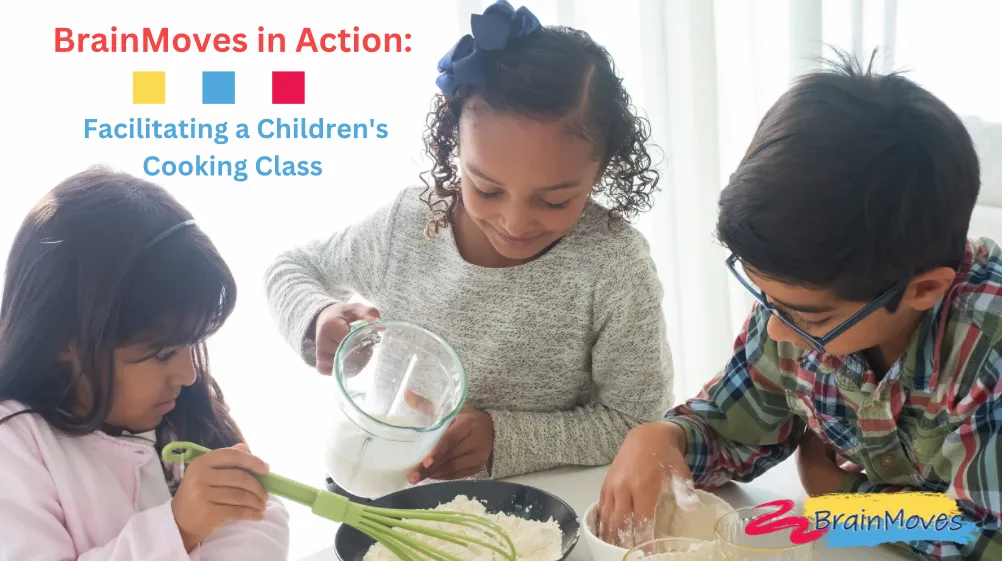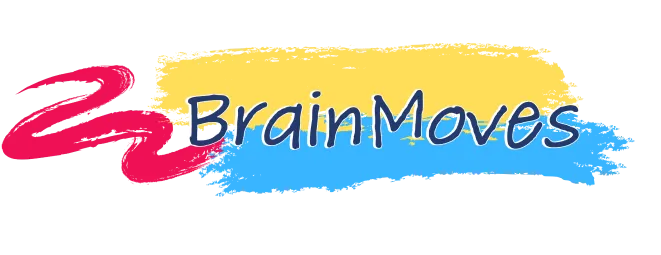
BrainMoves in Action: Facilitating a Children's Cooking Class
Hi friends, you all know me, but you don’t really know me. My name is Elizabeth, and I help Diane Malik

and BrainMoves with their marketing and support their website. I am also a trained and certified personal trainer, movement therapist, and yoga instructor. My job is to train and facilitate in a variety of settings, from performance to life skills like cooking, to movement therapy using BrainMoves, somatic therapies, and yoga. I love helping people with diverse brains and different abilities live their fullest and happiest lives, whether they’re pursuing the basic act of moving from place to place or a new hobby like cooking or performance driving.
People say that this makes me seem all over the place, but the common thread is that if a human being is well-regulated and enjoying their school, work, and playtime, they’re living their best life and helping their friends and families live better lives through co-regulation.
Over the next few months, I will be writing a periodic column to share how I use BrainMoves in my work with different populations. Hopefully, this will help you see how you could apply the ideas of somatic supports and scaffolding with the simple actions of BrainMoves.
I’m going to talk a little bit about the classes that I teach for Kids Test Kitchen—shout out to Kim and Emily for being absolutely awesome! For this group, I facilitate weekly sessions with 3 to 12 children between the ages of seven and twelve. Over the course of an hour, we work together to cook a delicious meal, including chopping, grating, measuring, and cooking over a hot plate.

What I love about facilitating this age group is how eager and open they are to new information, and how much they love mimicking. They desperately want to do adult things and help out, so they light up when you show them how to make food their parents would eat or how to do a skill they’ve seen an adult do but have no idea how to approach.
The children get so much from these classes:
On the functional movement side, the children are learning gross and fine motor skills, and I work to gradually move them from using kid-safe knives to using adult knives.
They’re practicing their reading skills by learning how to read recipe cards and then using focused attention to turn the words into actions like chopping and prepping.
They’re learning to share because there are never enough tools for all twelve children to do every task at the same time, so they’re practicing the patience of waiting, queuing, and being aware of time.
They’re also practicing their math skills by measuring, and because all of this is new, I often ask them to sit and pay attention even when they are very, very stimulated.
Many children in my group present with some type of neurodiversity, and all children at that age are bundles of activity, so it’s not uncommon for them to be bouncing off the walls.
I’ll use some simple BrainMoves activities to help them focus.
I’ll use the Koala and ask them to rub their ears before they get started to help them listen and pay attention. There’s a lot of stimulation in the room, and I want them to listen to me and pay attention to the person next to them.
I will use the Blowfish to help with speaking, breathing, and of course, chewing and paying attention to the food in their mouths!

It’s also common for me to use parts of the StartUp Six. I also ask them to wash their hands, be aware of their bodies, and drink water. Because we have to work with clean hands, I modify all of these activities to focus on physical awareness. This could include squeezing their hands, touching their arms, stretching, and focusing. We have rules: if they touch their body, they have to rewash their hands. Often, I’m helping them relax their limbs so they’re more comfortable doing things like chopping, measuring, and stirring the food.
However, what I’ve learned in my time as a movement therapist is that doing a little bit of movement often is better than trying to do the movement perfectly but infrequently. When I need to regulate the children, if they’re bouncing off the walls and moving too much to have any sharp objects or be near hot liquids, getting them to do a little bit of BrainMoves—even for just a couple of seconds—can change the mood of the room and allow me to regain control over the space.
You can use BrainMoves to help make your home and classroom more peaceful. It’s simple, straightforward, and easy to do. I often find that I get as much value out of doing the BrainMoves activities as the children do. If you’re ready to start today, you can find the self-paced online course on our website or sign up to be notified when we have a live workshop.
I’m so grateful that I learned the skills in the BrainMoves course. They make my work with children and adults of all ages and abilities so much easier, richer, and more fulfilling. I know that you will also have positive experiences using BrainMoves in your school, work, and at home.


